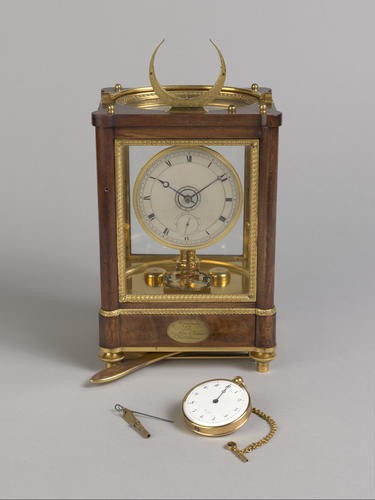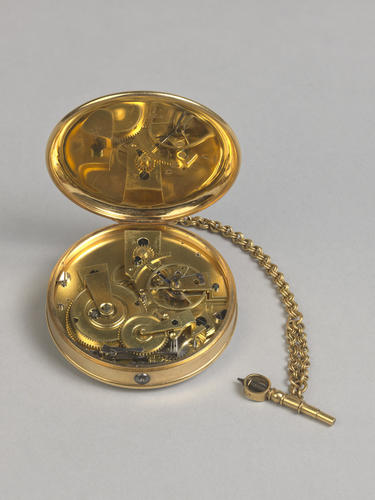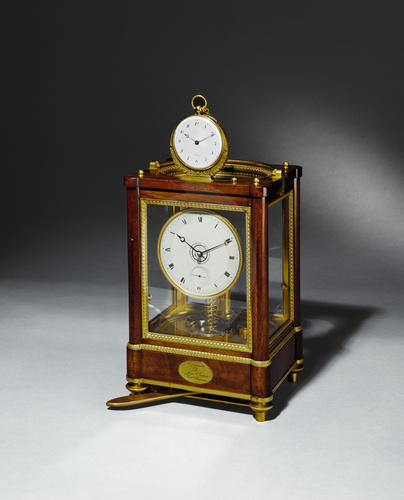The 'Sympathique' clock 1814
Mahogany glazed case with chased and gilt bronze mounts, clock with silver dial, watch with enamel dial | 33.3 x 17.5 x 17.5 cm (whole object) | RCIN 2861





-
A sychroniser clock which sets and regulates an associated watch.
Upright rectangular case with rounded corner pillars, each pierced with a single hole through which, when pressure is applied, the spring catches and controls the four glazed doors which are released and sprung open. Gilt bronze mouldings frame the glazed doors and the oval glass panel inset into the top, the former chased with water leaves and the latter with stars on a striated ground. The case, which is supported on four peg-top feet of gilt bronze, is fitted with a hinged carrying handle and, on the front forming the cresting, a cradle engraved with crossed laurel branches into which the gold watch is fitted; attached to the watch is a gold key on a chain.
The clock is enclosed in the case and is a 2 day timepiece with a going barrel movement and Breguet’s constant force spring detent escapement, the balance and helical balance spring being visible below the dial. At the base of the case is a reciprocating lever for winding the clock. The face has a gilded surround and silver engine turned centre with the 12 hours represented in Roman numerals and a subsidiary seconds dial at 6 o’clock. The centre has a disc which sets the time of release of the synchronising action. Three hands: a pair of blued steel Bregeut moon hands on the clock, a simple hand on the seconds dial.
The 30 hour watch is supported by the cradle. It has a going barrel movement and cylinder escapement. The enamel dial has the hours represented in arabic numerals and a pair of blued steel Bregeut moon hands.
The watch and clock are linked by means of a pin fixed behind the clock dial via the cradle. Built into the watch is motion work which, when released by the clock, automatically sets the hands to the clock's time as well as correcting the watch's regulator necessitated by any degree of inaccuracy registered at the moment of synchronisation.
In a letter to his son dated 26 June 1795 Breguet describes the purpose of the sympathique. 'I have invented a means of setting a watch to time, and regulating it, without anyone having to do it. The most coarsely made watch, provided it does not stop, will serve its owner as though he had a garde temps. This is how it works: you have a second clock or a marine arranged to receive the watch ... every night on going to bed, you put the watch into the clock. In the morning, or one hour later, it will be exactly to time with the clock. It is not even necessary to open the watch'.
The term sympathique was chosen by Breguet to express the notion of harmony and concord. The clocks and watches were never intended to advance the science of horology but conceived with the express purpose of demonstrating Breguet's genius for solving mechanical problems and, at the same time, producing works of visual and technical virtuosity.
Engraved on the oval plaque on the front of the case: 'Echapement/ Libre/ à force Constante/ Par Breguet. Engraved on a silver disc on the top of the column within the case: 'Breguet/ et Fils/ No.666'. Enamelled in black on the white enamel dial of the watch: 'Breguet'. Engraved on the inner dust cover: 'No.507/ Breguet', the number also stamped on the inside of the case and on the movement (Abraham-Louis Breguet 1747-1823 and Antoine-Louis Breguet 1776-1858). The watch case is struck with the Paris second standard mark (AG below an 8-pointed star within a triangle).Provenance
Made for the Prince Regent in 1814 and sold to him for 11,500 francs. Whilst no reference can be found with regard to delivery to Carlton House there is a reference that it was sent to Breguet and Fratton (Breuget's nephew) on 1 June 1826 for repairs costing 6 guineas. There are further references to repairs in December 1827, again by Breguet and Fratton (5 guineas) and in 1829-30 further cleaning and repairing by Charles Brandt of Jermyn Street (10 guineas). A Buckingham Palace Inventory of 1892 states that the watch was worn by George IV and the references to these regular repairs may well confirm this.
-
Creator(s)
(clockmaker)(repairer)(nationality)Acquirer(s)
-
Medium and techniques
Mahogany glazed case with chased and gilt bronze mounts, clock with silver dial, watch with enamel dial
Measurements
33.3 x 17.5 x 17.5 cm (whole object)
Alternative title(s)
Mantel clock and watch
Place of Production
Paris [Île-de-France]









